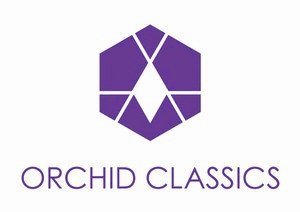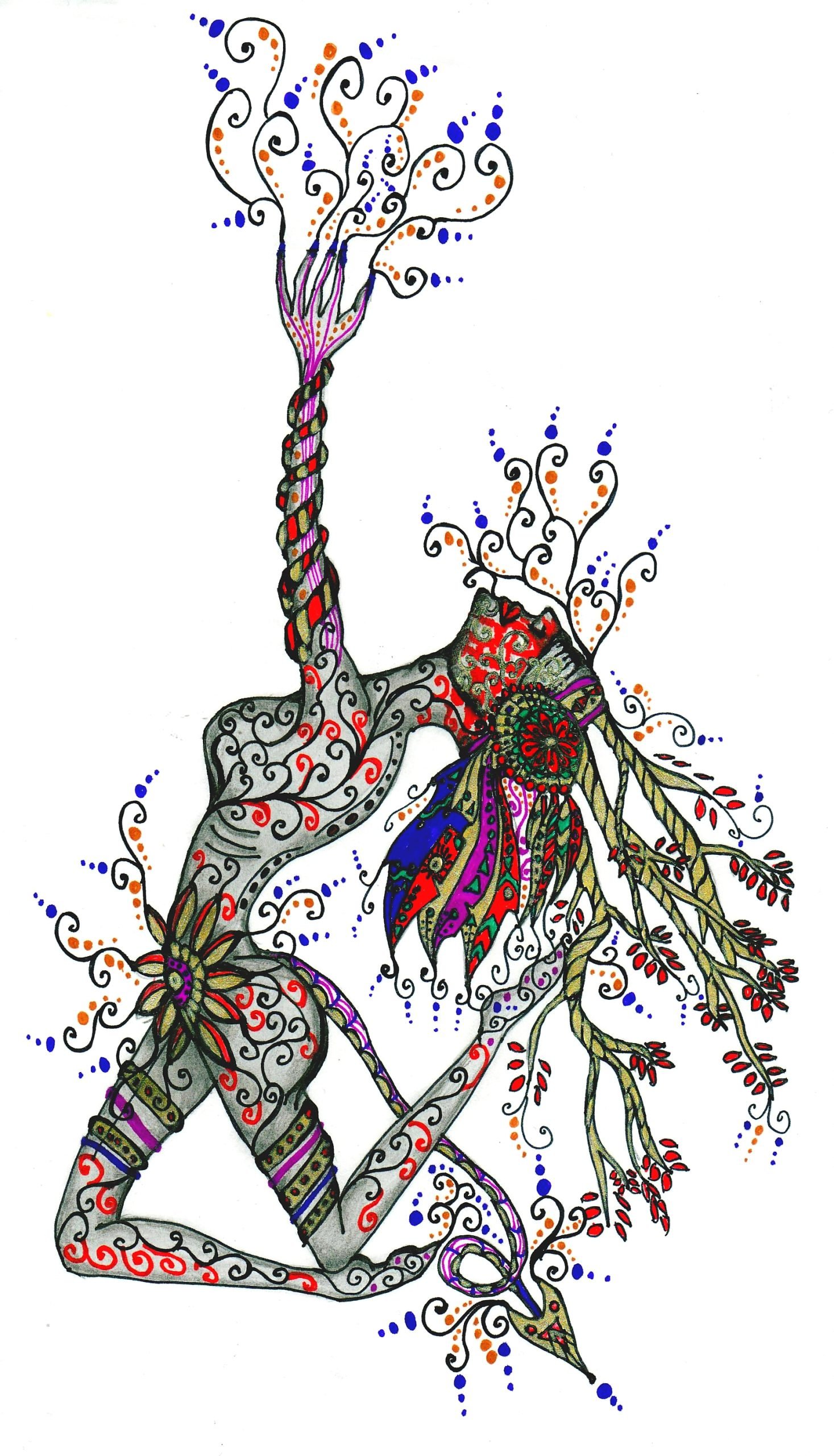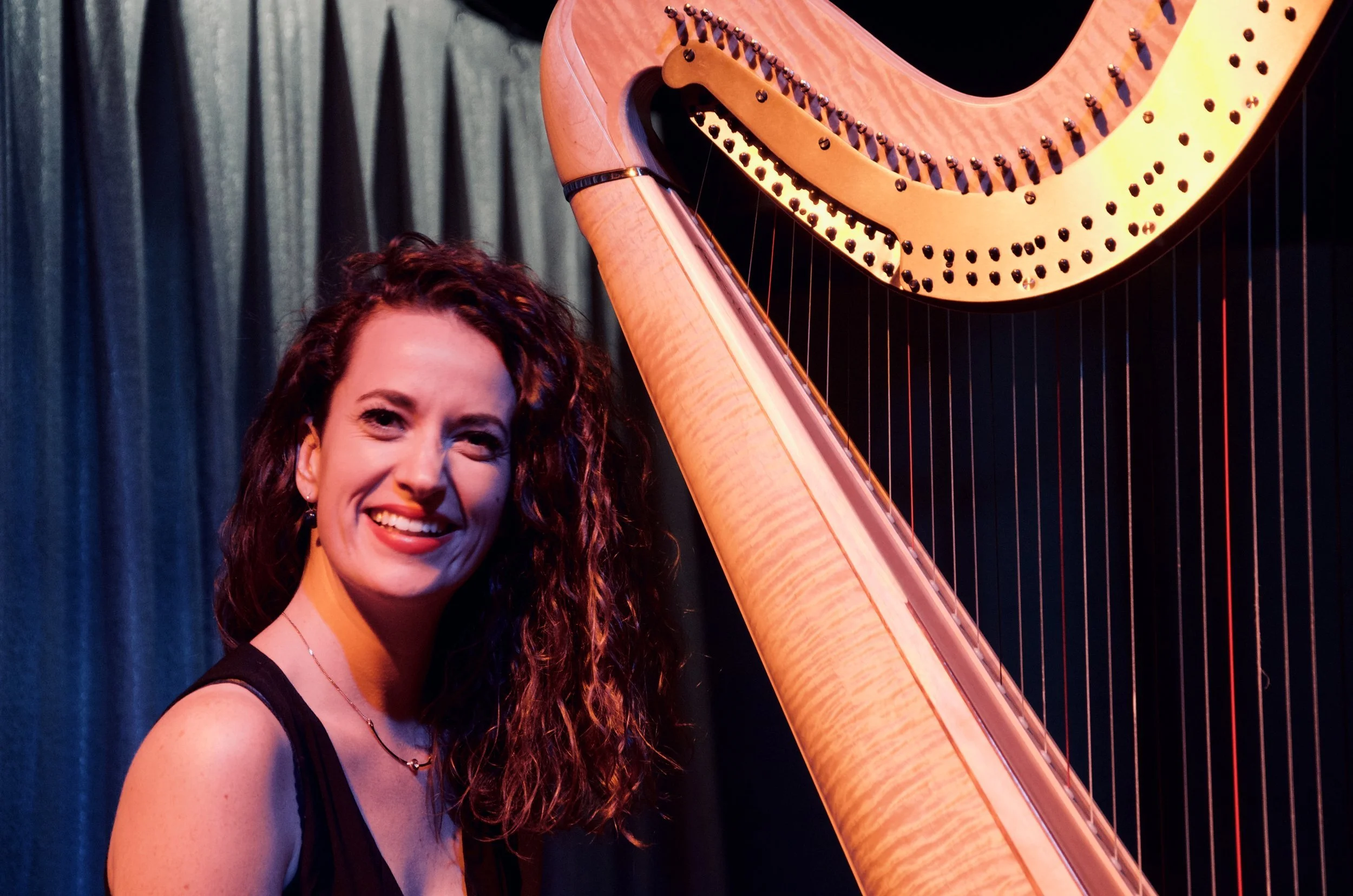“I was intrigued and seduced from the start…highly seductive sound mode…the landscapes revealed or suggested as the piece unfolds, are often spellbinding and/or effectively expressive… great music evocative of sumptuous panoramas…contemplative hypnosis. We’re not listening to a timeless sound world; we’re being sucked into it! A real gem.”
—Frédéric Cardin, PAN M 360
visit Orchid
FROM SAPPHO’S LYRE
Caravassilis has undoubtedly established himself as the preeminent composer dedicated to the unparalleled legacy of Sappho of Lesbos, the archaic Greek lyric poet from the 7th and 6th centuries BC. Algernon Charles Swinburne, the esteemed British poet, expressed that Sappho is unequivocally "the greatest poet who ever was at all," leaving no doubt about her profound intertemporal influence and importance.
In a seminal collaboration with NYC author and poet, Jeffrey M. Duban, Caravassilis presents a groundbreaking double album that focuses exclusively on his Sappho and sapphic-inspired compositions, in partnership with British record label Orchid Classics. This remarkable endeavor, the first of its kind, showcases the depth and breadth of Caravassilis' artistic mastery.
—Disc 1: From Sappho's Lyre
The first disc of this double album is devoted to From Sappho’s Lyre, a multimedia, scenic cantata for two solo voices, chamber orchestra and choir, pre-recorded audio, idiophones, and narrator. The cantata’s architectural arching and form combine elements of ancient Greek tragedy with Western ballet and opera. Within this hybrid form, Caravassilis uses two of Sappho’s original poems surviving in their entirety: Hymn to Aphrodite and Equal to the Gods. The poems are used in their original Aeolic Greek versions and Duban’s sensational English adaptations.
From Sappho’s Lyre transports and trancends listeners, leading them on an emotive journey inspired by these timeless verses while weaving a sonic tapestry that is both ‘quite old and brand new.’
—Disc 2: Five Duban Songs: Eros Sanctified; My Life a Lyric Cry; Sappho de MytilÈne
The second disc features three major works: Five Duban Songs: Eros Sanctified for mezzo and orchestra, using Duban’s own poems from his book The Shipwreck Sea, the cantata My Life a Lyric Cry using Sappho, a poem by Pulitzer Prize winner Sara Teasdale (1884-1933), and the award-winning song cycle Sappho de Mytilène (the earliest piece on this album), which uses reworked fragments of Sappho’s poetry by Nobel Prize laureate Odysseus Elytis (1911-1996) in their French version (translated by Veronique Perl).
The works on this second disc delve into the complexities of human emotion, encompassing love, longing, passion, lust, desire, anxiety and introspection. In this collection, Caravassilis showcases his versatile musical style, ‘effortlessly blending traditional and contemporary elements.’
To enhance the impact of his compositions, Caravassilis has assembled an extraordinary list of performers. The Grammy-winning Tallinn Chamber Orchestra, renowned for their timeless interpretations of Arvo Pärt's works, lends their exceptional talents to this project. Moreover, the Tenth Muse Ensemble, meticulously curated by the composer, adds a layer of artistry to the album, ensuring an unparalleled musical experience. Our cellist, Sophie Shao, plays on an extraordinary Honoré Derazey cello previously owned by Pablo Casals. Also in the artist rostrum are oboist Katherine Needleman, who joined the Baltimore Symphony as principal oboist at age 25, soloing and recording with it ever since, and mezzo-soprano Ariana Chris, who has been heard by millions singing the Greek Anthem in the Vancouver Olympics (2010).
For a more comprehensive understanding of Caravassilis’ vision and the intricacies of each composition, we invite you to browse through the album's prospectus below. This document provides a deeper insight into the inspirations and creative process behind this unique project, offering an intimate glimpse into the artistic minds of Caravassilis and Duban. Prepare to embark on a musical odyssey through the evocative world of Sappho. With 135 minutes of meticulously crafted music, this collection represents the culmination of Caravassilis’ artistic prowess and marks a milestone in exploring Sappho's enduring legacy.
Read more about the central themes of From Sappho’s Lyre, which are portrayed in a series of thematic illustrations created by our extraordinary clarinetist, Noemi Sallai.
—Introduction
Jeffrey Duban: The title of Constantine Caravassilis’ From Sappho’s Lyre is a variant on the title of my book, The Lesbian Lyre. Taken together, the two titles give us Sappho, the famed lyric poetess of the 7th and 6th centuries B.C., in the words of British poet Algernon Charles Swinburne (1837-1909), “simply nothing less—as she is certainly nothing more—than the greatest poet whoever was at all.”
Constantine Caravassilis: The creation of musical settings for 2,700-year-old poetry was unquestionably the most challenging task I have ever undertaken as a composer. In From Sappho’s Lyre, the title piece work, I have fused elements of ancient Greek drama and Western ballet and opera, creating a hybrid structure within which Sappho’s poetry is woven around Jeffrey Duban’s translations. These two linguistic worlds provided a template that I have over-scripted with a wide array of soundscapes, all contained within the text and surrounding themes.
Once the piece was composed and recorded, I found that our clarinetist, Noemi Sallai, had made a number of paintings based on her impressions of the music. The illustrations are exactly what I had in mind during the compositional process and perfectly complement both the literature and music.
—the lyre
JD: Sappho was born, lived, loved, and composed her poetry on the Greek island of Lesbos—the third largest of the over 700 Aegean Greek islands—with its fabled capital of Mytilene. Sappho composed and sung her poems to the lyre, hence “lyric poet/poetry.” “The Lesbian Lyre” designates the location of Sappho’s origin and music-making on Lesbos. “Sappho of Lesbos” or “Lesbian Sappho” were, for millennia, titles essentially associating Sappho with her island homeland.
CC: Duban’s translations and original poetry add color-filled auras and sparkling nuances throughout. In addition to the sonic portrayal of various images and emotions elicited by the text, I have enriched the work with elements signaling dance and movement, lighting, and other means of spectacle accompanying live performance of this work, and with pre-recorded sound effects projected from carefully placed loudspeakers throughout the performance space. This provides the “listener” with an integrated audio-visual experience.
—sappho in movement
JD: The depictions that follow show a flamboyantly stylized Sappho in movement—dance inextricably tied to lyrical poetry and song. This can be a strange notion to contemporary readers of poetry for whom poems are not concurrently composed and performed but appear as written texts to be read and possibly sung. Today, when written texts are put to music, they become “art songs.” But such from the outset was the status of all ancient poetry—even of heroic epics, believed, at a minimum, to have been chanted to lyre accompaniment. In sum, there was no distinction, as there is today, between poem, song, and movement.
CC: In From Sappho’s Lyre, I treat the ancient Greek poetry as the sacred and the Duban translations as the secular/profane. I use both to offer imposing musical structures reflecting earnest emotion and continuous forward momentum. Inspiration has come from many sources, including Jeffrey Duban’s The Lesbian Lyre, my Aegean upbringing, world music, and others.
—phaon
JD: Sappho was a lover of both women and men, but predominantly of women, as her surviving poetry and ancient testimonia provide. While the “suspect” nature of Sappho’s loves elicited comment in antiquity, it would not be until the nineteenth century that “Lesbian Sappho” would come to mean “Sappho the Lesbian,” and “Lesbian,” at first in medical contexts, an indication of sexual proclivity rather than of geographic locale. For all that she was “lesbian,” Sappho was married and had a daughter, Cleis (whom she mentions in her poetry). She was further believed to have ended her life in a leap from the Leucadian cliff in despair of her unrequited love for the ferryman Phaon (here imaginatively depicted in all his standing beauty).
CC: The momentum of From Sappho’s Lyre proceeds from an appreciation of the semantic range of key words—i.e., the words’ several innuendos or meanings— and from creating aural paintings molded to the same shapes and colored to comparable shades. The main thematic material appears several times including the start and finish of the work, and at other key points. Here, Sappho’s sexual proclivity and ambiguous nature of her sexuality is expressed by assigning the same melody (albeit somewhat transformed) to different kinds of voice, including that of a tenor, a countertenor, a mezzo-soprano, and finally a cantor via my own voice in pre-recorded movements.
—the beast
JD: Love is also beastly, Sappho elsewhere describing it as an erpeton (crawler, slitherer), “a dissolver of limbs, bittersweet, creeping in.” The notion is here imaginatively conveyed by a colorful lumbering beast with its extended, phallically snakelike tail.
CC: With the images reflecting the poetry’s thematic import, there is an additional unifying element: Jeffrey’s narrations in Sapphic/Aeolic Greek. As From Sappho’s Lyre uses the two Sapphic poems long believed alone to have survived in their entirety (others since discovered), I selected key sections of each work and composed music complementing the narrations as a whole. This serves several purposes. Dramatically, these are the moments where the spotlight falls on the original text. Musically, these moments are conceived as thresholds, offsetting consequent movements where the poetry is set to song.
—the firebird
JD: The intensity of Sappho’s love, inviting physical and psychological dissolution unto death—is conveyed by the image of the firebird, its wings emanations of flame, and is seen in the poem “He appears to me.” Such intensity is reminiscent of the love described in the biblical Song of Songs,” establishing the concord of love and death:
For love is dire as death,
its grip the grave’s, and grim;
its flames a conflagration,
God ablaze.
CC: It is that physical and psychological dissolution, as Jeffrey describes it, that helped me attain the intensity in the second half of From Sappho’s Lyre. The first over intense moment is reached by a highly expressive solo cello and its aftermath (movements VIII and IX; Invocation & Rupture). The intensity continues with the sounds of singing air (movement XII, Cosmic Canticle), the soprano aria (movement XIV, Zenith), and the sonic depiction of multiple realities, including erotic scenes by the sea and memories of war and peace, all within a movement called Dream Within (XV).
Meet Our Artistic Team
—featured reviews
I didn’t know what to expect when I began listening to this contemporary multimedia cantata by a Canadian composer of Greek origin whom I didn’t know at all. Well, I was intrigued and seduced from the start by this modern encounter with the famous poetess Sappho of Mytilene, who lived on Lesbos island, Greece, in the 7th century BC. The two surviving poems by the artist served as sources for Jeffrey M. Duban’s landmark book The Lesbian Lyre: Reclaiming Sappho for the 21st Century. There, the American scholar places Sappho in her historical context and offers a new translation of her works. And that is where our fellow compatriot comes in.
Caravassilis, with his vivid imagination as a musical creator, immediately transports us into a highly seductive sound mode, that of an ancient Greece fantasized and transcended, thanks to a transfigured modal writing skilfully revisited with a few modern techniques. This sometimes bewitching plunge into distant Greece oscillates between modal language (which sounds “ancient”), impressionist chromaticism and romanticism, but also minimalism. A rather eclectic chamber orchestra (containing santour and many percussions), is beefed up by discreet electronic triturations and concrete sampling (natural bird sounds, for example). Caravassilis completes this already rich fabric with a choir and solo voices who are asked to master traditional lyricism alongside arabesques reminiscent of ancient oriental chants or, let’s say, based on musicologists’ suppositions of melodies heard in ancient Greece.
The whole thing could have been a mess, but Caravassilis’s dramatic focus, and the landscapes revealed or suggested as the piece unfolds, are often spellbinding and/or effectively expressive. We’re quickly hooked on this proposition, which regularly has the effect of contemplative hypnosis. We’re not listening to a timeless sound world, we’re being sucked into it!
New York’s Tenth Muse ensemble (in homage to Sappho of Mytilene, whom Plato considered the ”10th Muse” of the gods), a motley chamber orchestra coupled with a choir whose members were personally chosen by the composer, is the cornerstone of this performance, the vehicle that allows us to cross time and space so convincingly. The voices, so beautiful, so idiomatic in their evocations of ancient songs (recent musicological research is somewhat responsible for this new understanding), serve the proceedings through orientalising solo interventions and choral passages that recall, of course, the choirs of ancient Greek tragedies. I dream of seeing this cantata in the conditions it was intended, with multimedia projections and dance, even if the musical version alone is more than enough to convince us of its great quality. A real gem.
But that is not the end of the journey. The Sapphic cantata is only the first of two discs on this album. The second is devoted to other pieces by Caravassilis inspired by poetry and ancient Greece, again Sappho. Five Duban Songs: Eros Sanctified transposes into inviting lyricism extracts from The Shipwreck Sea: Love Poems and Essays in a Classical Mode by the same author as in the Cantata, inspired by ancient poetry. This is followed by two other song cycles: My Life a Lyric Cry, on poems by Sarah Teasdale (1884-1933), inspired herself by Sappho, then Sappho of Mytilene, on fragments of Sappho’s texts translated into modern Greek by Odysseus Elytis (1911-1996), and used here in a French translation by Veronique Perl.
In Eros Sanctified we find Caravassilis in territory that is often neo-Romantic with a modal touch or minimalist in inspiration, like Arvo Pärt in his Symphony No. 3, Gorecki in his Symphony of Sorrowful Songs or Philip Glass in his own symphonies. The final effect is that of great music evocative of sumptuous panoramas and perhaps of very fine documentary films. My Life a Lyric Cry is more traditionally modern (Britten, perhaps, springs to mind) while Sappho of Mytilene returns to the atmosphere of the cantata, but in a pared-down format for mezzo-soprano (Ariana Chris’s very, very fine voice), flute and piano.
It’s frankly beautiful and original in its ecumenicalism if we take into account the cantata on the first disc. Contemporary music that is resolutely accessible and satisfying for everyday people and connoisseurs alike? Yes, it exists, and we like it a lot.
—Frédéric Cardin, PAN M 360
From Sappho’s Lyre is a double CD of music by Constantine Caravassilis. There are four cycles for voice and various combinations of instruments, all, as the album title suggests, related to Sappho of Lesbos. The first is a setting of her Hymn to Aphrodite; the longest, extant work. It’s intended to be performed as a “spectacle” with dance, costumes etc. It’s scored for soprano (Liana Guberman-Chriss), mezzo soprano (Carla Jablonski), countertenor (Daniel Moody), narrator (Jeffrey Duban), chorus, eight-piece chamber ensemble (Tenth Muse Ensemble) and recorded sounds, and it’s conducted by the composer. It’s sung and narrated in a mixture of Ancient Greek and English, and it’s richly orchestrated. It’s complex but mostly tuneful music with quite dense textures and lots of percussive effects. It’s really a very distinct musical voice, as becomes clearer as one progresses through the pieces on the records.
Equal to the Gods (He Appears to Me) is another setting of the text by Sappho; again, in a mixture of Ancient Greek and English translation and uses the same forces as the Hymn. There’s more use of pre-recorded sounds here and generally a more frantic feel to the piece as it wrestles with Sappho’s unrequited passion. But again, it’s colourful and evocative, with very dramatic sections contrasting with something more lyrical.
The second CD begins with Five Duban Songs: Eros Sanctified. This sets five Sappho inspired poems by Jeffrey Duban. It’s scored for mezzo soprano (Ariana Chris) and chamber ensemble (Tallinna Kammerorkester) and is conducted by Kaisa Roose. This piece oozes sexuality even though in one place it sounds distinctly like a Bach chorale. It’s very lush, almost overblown in places, but quite satisfying.
My Life a Lyric Cry sets text by American poet Sara Teasdale, again inspired by Sappho, it’s scored for soprano (Jenni Klauder), piano (Maria Pikoula), cello (Sophie Shao), oboe/English horn (Katherine Needleman) and narrator (Jeffrey Duban). It’s another richly written piece with interesting use of the spoken voice narration and some really high, plaintive sections for soprano.
The final piece is Sappho de Mytilène. This is a setting of five Sapphic fragments translated into modern Greek by Odysseus Elytis and then translated into French by Veronique Perl. It’s scored for soprano (Ariana Chris), piano (Maria Pikoula) and flutes (Anna Urray). The five poems are set in quite a variety of styles. At times, it’s languorous and even voluptuous, but other sections are very busy, even anguished, and it finishes extremely playfully.
There’s over two and a quarter hours of music on the two CDs, and it’s all rhythmically, harmonically, and melodically inventive. There’s a lushness to much of the music that’s very appealing, but there’s variety too. I found some of the writing for tuned percussion very interesting, and the mix of high sung voice with spoken narration is effective. All in all, there’s lots to like and lots to explore.
The recordings were made on a variety of occasions, but any difference in acoustic is really not noticeable. The hi-res (96kHz/24bit) digital version of the recordings that I listened to had excellent clarity and range. It’s also available as physical CDs, CD quality FLAC or MP3. The booklet has full texts and translations and a wealth of other material about the poems, the music, and the general background to the project.
—John Gilks, Operaramblings
Constantine Caravassilis is the composer of From Sappho’s Lyre, a recording from Orchid Classics of original music played by Tallinna Kammerorkester and Tenth Muse Ensemble and vocal soloists, setting poetry by Sappho, Jeffrey Duban and Sara Teasdale, that might make a good gift for the classically minded listener at this time of year.
When I saw the cover and the sources, I was immediately reminded of Pierre Louÿs and his Chansons de Bilitis (Songs of Bilitis), known to readers and perhaps even more famous via Claude Debussy’s settings of the poems of his friend and room-mate. Louÿs was playing games with his audience via the claims of the authorship of the songs, which in fact were his modern compositions rather than discoveries of ancient texts.
In case you’re wondering why I’d be reminded immediately, it’s both as a pianist practitioner, as a Debussy scholar and as a fan of Louÿs having adapted his novel Aphrodite for the stage back in the 1990s. This entire discursive space of the classical poetic realm, whether real or fake, has intrigued me for literally decades.
So it was with some eagerness that I put Caravassilis’ music onto the CD player of my car to have a listen. It’s compelling listening.
Please note, these are modern compositions employing different groups of instruments, vocals and some narration. This is a mammoth recording, including some more modern sounding pieces. But I was especially captivated by the music inhabiting a middle ground between new-age meditative music and songs with more than a few hints of ancient days. Caravassilis shifts back and forth, employing a few different styles and idioms. When he’s in this one that seems like an evocation of the Ancient Mediterranean culture? I’m hooked. No it’s not as if we know what that music sounded like, nor does this really imitate that, but we’re not jarred, not disturbed from allusions and fantasies of the past. Yet it’s as ambiguous and poetic as the wind blowing through an empty amphitheater. We are in a tonal realm, melodic without being overly virtuosic. The voices address us in a curious middle-ground between passion and ritual, as we might expect for what we know of Sappho.
The music of From Sappho’s Lyre is often very beautiful. These songs have made a pleasant accompaniment to my driving, that I recommend.
—Leslie Barcza, Barczablog



































